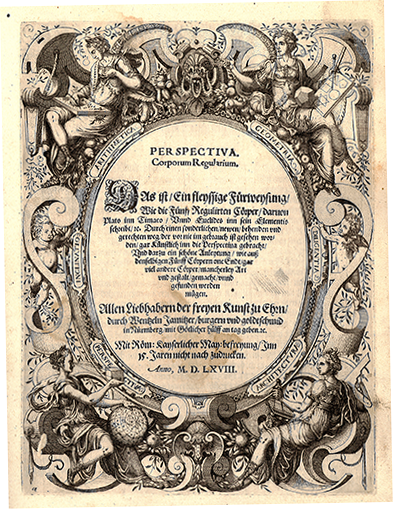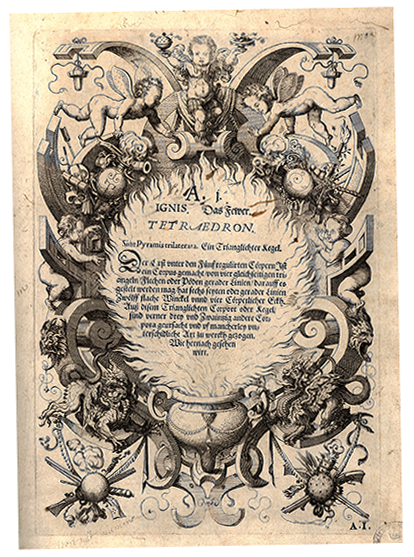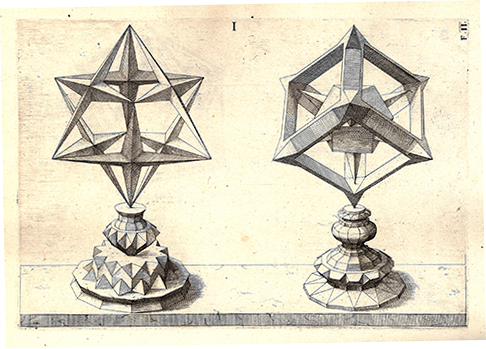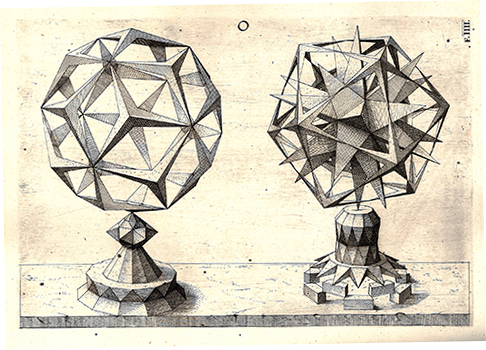- About MAA
- Membership
- MAA Publications
- Periodicals
- Blogs
- MAA Book Series
- MAA Press (an imprint of the AMS)
- MAA Notes
- MAA Reviews
- Mathematical Communication
- Information for Libraries
- Author Resources
- Advertise with MAA
- Meetings
- Competitions
- Programs
- Communities
- MAA Sections
- SIGMAA
- MAA Connect
- Students
- MAA Awards
- Awards Booklets
- Writing Awards
- Teaching Awards
- Service Awards
- Research Awards
- Lecture Awards
- Putnam Competition Individual and Team Winners
- D. E. Shaw Group AMC 8 Awards & Certificates
- Maryam Mirzakhani AMC 10 A Awards & Certificates
- Two Sigma AMC 10 B Awards & Certificates
- Jane Street AMC 12 A Awards & Certificates
- Akamai AMC 12 B Awards & Certificates
- High School Teachers
- News
You are here
Mathematical Treasure: Wenzel Jamnitzer's Platonic Solids
Perspectiva Corporum Regularium, published in 1568, is one of the most mathematically fascinating books of the Renaissance. Its author was Wenzel Jamnitzer (1508-1585), a renowned Nuremburg goldsmith, designer, and inventor of scientific instruments. In this study of the five Platonic solids, Jamnitzer truncated, stellated, and faceted the regular solids to produce 120 variations, twenty-four variations of each solid. All these creations were illustrated by detailed engravings.

Figure 1. Title page of Wenzel Jamnitzer's Perspectiva Corporum Regularium
In the cosmologic theory of the Middle Ages, all matter was thought to be composed of four elements: fire, air, earth, and water. Each element was represented by a particular polyhedron: fire by the tetrahedron; air, the octahedron; earth, the hexahedron or cube; and water, the icosahedron. The dodecahedron represented the universe or heaven. The title page describes the author’s task:
Perspectiva Corporum Regularium
Perspective of the Regular Solids: that is, a diligent exposition of how the five regular solids, of which Plato writes in the Timaeus and Euclid in his Elements, are artfully brought into perspective using a particularly new, thorough, and proper method never before employed. And appended to this a fine introduction how out of the same five bodies one can go on endlessly making many other bodies of various kinds and shapes.

Figure 2. Each of the Platonic solids was given its own chapter with an introductory page. Above is the introduction for the tetrahedron, or fire (ignis).

Figure 3. Six variations of a tetrahedron

Figure 4. This is the introduction for Terra, Earth.

Figure 5. Some variations on the hexahedron or cube

Figure 6. More variations on the cube

Figures 7 - 11. The viewer can attempt to interpret the polyhedral variations and the items associated with them in the image shown above and in the four images below.




A more complete viewing of Jamnitzer’s polyhedral creations can be found at the BibliOdyssey website.
Acknowledgment
The images presented above were obtained through the kind cooperation of the Museum of Science, London, UK, and the personal assistance of Douglas Stimson, Assistant Archivist. You are welcome to use them in your classroom; for all other purposes, please contact the Museum of Science.
Frank J. Swetz (The Pennsylvania State University), "Mathematical Treasure: Wenzel Jamnitzer's Platonic Solids," Convergence (August 2013)




